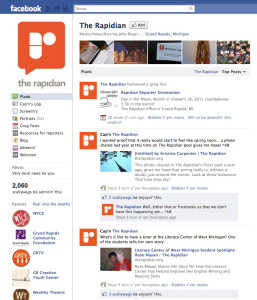Listening is Power in Social Media
Social media is more than a tool for news organizations to push out coverage. There are several ways reporters and editors can use the platforms to expand coverage and develop new ways to listen.
Honing in and listening to your social media network makes it easier to find sources, build relationships, learn about breaking news, gather opinions and promote your work.
Your personal friends can be an excellent source of community information. Pay attention to the posts on your wall and on your homepage. Neighborhood updates, event listings and conversations between friends can offer insight into pressing community issues.
It’s easy to get overwhelmed by the firehose of posts from the people you follow. The best way to monitor social media sites, Twitter and Facebook in particular, is to use a free, column-based, dashboard-style tool like Tweetdeck, Seesmic, or Hootsuite. (See the Deeper Dive: Twitter section (LINK) for more about these tools.)
You can set up columns or widgets to focus on specific types of social media posts:
- Public replies and private messages made to you. You want to know immediately when someone’s trying to get your attention.
- Sub-groups of people or groups that you follow, such as your professional colleagues, community leaders, fellow Phillies fans, etc.
- Responses to, or mentions of, you or another social media user, via a search string, such as: oaklandlocal, @oaklandlocal or “Oakland Local.”
- Keywords or hashtags mentioned by anyone via a search string. This can be about an ongoing topic, such as: #smartgrid, #smartmeters or “smart meters.” It can also be for a temporary event such as: #ONA or #ONA2011.
Funneling important kinds of social media updates into columns makes them easy to see, and for social media, “seeing” equals “hearing.”
Mining information
Social media can be your radar screen, serendipity engine, conversation trigger and early warning system. What should you look for, and what should you dowith that information?
Here are just a few possibilities:
- How many people are discussing, or appear interested in, topic X? This indicates the size of potential community or market.
- Who are the leaders in the current public conversation about topic X? You should follow influential individuals more closely, and perhaps even reach out to them personally.
- What is the tone and range of views being expressed about topic X? Use timing, tone, and context as clues for how you interact with people via social media.
- What questions do people have about topic X? Look for opportunities to gain attention and build relationships by creating content or posting links to fresh content, or by engaging in public conversations.
- Who are my allies and critics? These are people who share your posts with their networks. Both allies and critics are useful: Allies can amplify and spread your information, bringing you more attention and support. Critics represent opportunities to engage in a civil public discourse.
Prove that you’re listening

The Rapidian’s Facebook page.
Social media offers a great environment for your audience to feel heard and appreciated. In general, at least half of what you post to social media should be retweets, likes, or other kinds of sharing of interesting, fun, or relevant items that others have posted. It’s flattering, and being nice to people is a great way to build relationships and start conversations.
Be careful, however, not to jump into discussions or join groups with the sole purpose of reporting on a story. Think of social media like a traditional news beat where relationships and trust are key to gaining insight. Always strive to bring value to the conversation. This can be in the form of answering questions, providing context and sharing resources with your online community, providing that this sharing is in line with your news organization’s policies.
Sharing the best of what you hear from the community you seek to engage is the easiest way to come up with useful things to post. That takes some of the pressure off of consistently updating your social media; you can get more engagement done in less time by echoing what you hear.
The emerging ethics of social media
When contacting potential sources or joining groups for research purposes, be sure to identify yourself as a reporter or representative of a media organization when appropriate. Just like in print reporting, trust is an important part of social media and misrepresenting yourself could be a quick way to lose trust.
While social media can be an efficient tool to find new connections and information, always be sure to verify everything. Ask contacts to verify their identities and double check leads with several sources before publishing.
Be aware of ethical issues that may arise when joining groups and liking pages. In certain situations, such as during sensitive political or financial investigations, these gestures can be seen as favoring or ignoring certain groups. But it’s also important to remember social media’s tenants of transparency.
Do you talk about developing stories on social media? Use your judgment
A similar conversation should be had about how much information to share about upcoming stories. While there are certain situations, such as sensitive investigative work, that would require more reservations, it’s often the case that posting information or questions about upcoming stories can unearth new sources and community perspectives.
Real-time updates are one of the most beneficial aspects of social media. When you’re not able to get to a location personally, checking status updates during breaking events can provide a sense of context and story leads.
Likewise, reporters who “Live Post” during breaking news events find it’s a great way to gain attention for an individual reporter or a news organization. Most cell phones have applications that allow people to post text, photos and videos directly to social media sites.
Should you friend sources – or the Mayor?
If you use social media as a reporting tool regularly or if you have already built a following for your work, you’ll likely receive friend requests from sources and followers who may not want to see your personal information.
In these cases it’s a good idea to separate friends in your personal account into lists, which Facebook allows you to do. These lists can be categorized as “Personal,” “Business,” “Story sources,” etc. and after the lists are set up you’ll be able to choose which lists see specific posts.
If you are well-known (or feel you are) another option is to create a public fan page on Facebook, using the Pages function, under your own name, where readers, colleagues and casual acquaintances can see your most recent public information. Likewise, you may want to create a separate Twitter account to handle your personal correspondence.
Must-Have Tools for The Rapidian
 Laurie Civello, Publisher, The Rapidian, laurie@grcmc.org, http://therapidian.org
Laurie Civello, Publisher, The Rapidian, laurie@grcmc.org, http://therapidian.org
What are the must-haves for The Rapidian to manage social media?
Facebook: We post daily to alert about new content, ask questions, encourage participation, etc. This is the most significant driver of traffic to The Rapidian. In the past 30 days, 35% of our traffic came from Facebook (as opposed to 25% direct traffic). Articles linked to FB have higher views than those not. FB posting also gives encouragement and visibility to the community content providers whose work we highlight. While the Facebook “Insights” are not perfect, they are somewhat helpful.
Cotweet: Allows easy management of multiple twitter feeds and multiple folks utilizing. We also use it to space posts by scheduling them for a particular time.
Google Analytics: Helps us determine which social media tools are working for generating site traffic. We also use the notations feature to keep notes about relationships between content and visitor behavior.
